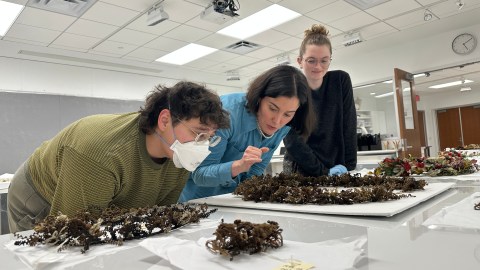Stages of Team Development
Identifying the stages of team development is important because how we build teams impacts how we operate within them, how we manage them, and how we achieve results. In 1965, educational psychologist Bruce Tuckman identified four stages of team development (“Developmental sequence in small groups,” Psychological Bulletin, 63, 384-399):
- Forming happens when teams come together—there’s excitement but people are a little unsure; they don’t know whom they can trust and they don’t necessarily know how they’re going to work together. In the forming stage there is little real focus (yet) on actually completing tasks, and little focus on building relationships beyond an exploratory level.
- In storming, the team has moved on to the next stage; they’re now focused on getting work done and completing tasks. But they may be pulling in different directions and there may be conflict that is either open or unresolved. Teams may be choosing artificial harmony over building relationships.
- In the norming stage, teams take a step back from the work and focus on how they are working together. How is each team member contributing to the results? Given that most American workers tend to focus on “getting the job done” and shy away from emotional openness, we have to step away from our teamwork long enough to get into the norming stage before we can get to the performing stage.
- The last stage, performing, occurs when team members have figured out how to pull in the same direction. Team members leverage complementary skills toward shared goals and create the synergy that comes with a high-performing team.
Typical Team Dynamics
Team Dynamics
- The first one, trust, is the most foundational. Lencioni defines this as the ability to make yourself vulnerable with one another, to admit mistakes and to ask people for input into how you can do your work better.
- The second level is healthy debate or conflict. Strong teams engage in healthy debate because they trust each other enough to know that conflict is natural and essential to achieving results. Members of healthy teams say what’s important and aren’t afraid to confront issues face-to-face with colleagues.
- The third level is a commitment to group decisions. With commitment (not to be confused with consensus) people are more likely to support decisions because they have shared their thoughts and have agreed to move forward, even if they “agree to disagree.”
- If everyone is committed to the group decision, people are more likely to hold themselves and their peers accountable for the decisions and subsequent actions.
- Lastly, high-performing teams tend to prioritize team results over personal agendas. If you begin the work of your team with the end in mind, it’s easier to move your team to results.
Team Dynamics and Organizational Culture
Team Dynamics in Action
- Help build trust. Even people who have been working side by side for years may not know a thing about each other. This is a great opportunity to get people to open up on some level to build the trust necessary to any successful team. Try asking team members to share their strengths and passions about their work or areas of their lives. Ask each person to take an online personality test to share with the group.
- Perform an assessment activity with your team and evaluate its results. Pay particular attention to team members who are “not into the ‘touchy-feely’ stuff.”
- Define what is and what is not within the scope of the team’s control. In some cases, boards and executives may have been working for some time on a needed transition, but have not yet shared details with the museum’s full staff. Teams may be appointed to implement a decision when team members may not yet have adjusted to the reality of the decision.
- Make a clean break with the past. When faced with change, try to move forward with the team, even if you don’t fully agree with all the decisions. If you’re a team member or the team leader, you may be so far ahead of others in making your way through the transition and it may be difficult for you to be empathetic with people who process information and take action differently. Allow some adjustment time for people to cope with the new reality.
- End debates when they devolve into simple naysaying. Wherever the team needs to come to a decision, have a process in place so you can collectively arrive at, “Okay, we’ve gotten all this out on the table; now let’s decide what we’re going to do.”
What about team members who simply will not change? The first thing to do is listen for what your team members are saying and what they’re not saying. If your team is dealing with change, you might hear someone say things like, “This is ridiculous. There’s nothing wrong with the way we’re doing things.” That’s a sign that the individual is stuck in transition. If you’re hearing things like “I’m overwhelmed, I feel completely lost, I don’t know how to get things done anymore,” the team member is in the neutral zone where the new way has started to take hold but the old way is not quite gone. At some point you may need to have a one-on-one conversation in which you’ll say something like, “This change is going to happen and we need you on board. Your unhappiness about it or your resistance to it is not going to stop it from happening. It’s only affecting your reputation within this organization.”
There may come a time when everyone has moved on and one person is holding the team hostage. You cannot permit that to happen—even if the person is you. Look ahead to implementation of the decision—something likely not fully under the control of the team members. Make sure that the team includes or consults with those who will be affected the most by the decisions you’re making.
A Checklist for Team Leaders
- Assign clear role
- Celebrate small achievements
- Try to be positive, honest and open
- Present a clear message
- Get clarity about information and decisions
- Give specific assignments
- Help enact change
- Own it
Activity for Assessing Team Dynamics

Activity
- As the diagram shows, your chart is like a wheel with several spokes. Draw three intersecting lines, creating six spokes. At the end of each spoke, write one of the following phrases:
- Ability to resolve friction, peer to peer
- Ability to prioritize for the good of the team
- Ability to engage in healthy debate
- Ability to be vulnerable with one another
- Ability to commit to group decisions
- Ability to pull in the same direction
- Next, assign a value to each of those spokes based on your perception of your team’s collective abilities. In the center is 0, representing lack of ability in any area; at the outer ends of each spoke is 10, meaning high ability.
- Consider your team’s abilities in each of the areas, and (each team member using a different color pen/marker) mark a dot on the spoke indicating where you/they think your team’s collective abilities are currently. For example, if your team is good at follow-through on tasks, you might mark a dot at “10” on the spoke labeled “Ability to pull in the same direction.” Alternately, if your team fights constantly with no resolve of real issues, you would mark a dot at “0” on the spoke labeled “Ability to engage in healthy debate.”
- Now (each team member using their color pen/marker) connect the dots with a line. At a glance, what does the chart look like with this overlay of each team member’s contributions? At a minimum the chart will reveal overall strengths of the team as well as fairly clear growth opportunities.
- Take time to discuss the team’s reactions to the chart, individually and collectively. What does the chart tell us? Where are our strengths? Where can we improve? What actions do we need to take to make that change happen?
An important point to be made here is that not all teams (and team members) need to operate at a “10.” “Seven,” “8” and “9” are great, while still leaving room for growth. We may not be a “10” in the ability to resolve friction peer to peer, but we may still accomplish our goals.
Gary Ford is principal of GLFord Consulting. Greg Stevens is assistant director for professional development at AAM. This article is reprinted from A Life in Museums: Managing your Museum Career(2012, The AAM Press) and is based on previous AAM management seminars and the AAM webcast series, Straight Talk: Communicating with your Staff, your Teams, your Boss, available in the human resources section of the AAM Recorded Webinar Library.








